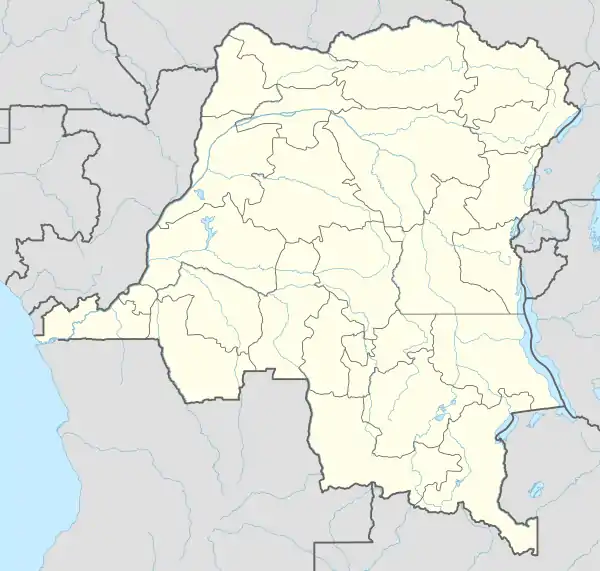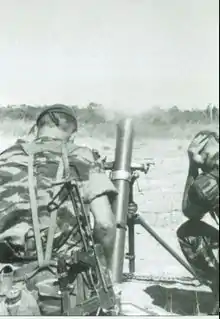Kolwezi
Kolwezi or Kolwesi is the capital city of Lualaba Province in the south of the Democratic Republic of the Congo, west of Likasi. It is home to an airport and a railway to Lubumbashi. Just outside of Kolwezi there is the static inverter plant of the HVDC Inga-Shaba.[4] The population is approximately 573,000.
Kolwezi | |
|---|---|
Provincial capital and city | |
| Ville de Kolwezi | |
 Kolwezi Location in the Democratic Republic of the Congo | |
| Coordinates: 10°43′S 25°28′E | |
| Country | |
| Province | Lualaba |
| Founded | 1938 |
| City status | 1971 |
| District | 1976–2015 |
| Founded by | Union Minière |
| Communes | Dilala, Manika |
| Government | |
| • Mayor | Véronique Upite Kamina |
| Area | |
| • Provincial capital and city | 213 km2 (82 sq mi) |
| Elevation | 1,448 m (4,751 ft) |
| Population (2015[2]) | |
| • Provincial capital and city | 572,942 |
| • Density | 2,700/km2 (7,000/sq mi) |
| • Urban | 480,000 |
| Time zone | UTC+2 (Central Africa Time) |
| Climate | Cwa |
Before the creation of Lualaba province in 2015 Kolwezi had two territories attached to it and the whole was known as the Kolwezi District.
Economy
Kolwezi is an important mining centre for copper and cobalt. There are also uranium, radium, oxide ores, and lime deposits. The Musonoi mine is a set of open-cut pits near Kolwezi from which copper and other metals have been extracted since the 1940s.[5] The nearby Lake Nzilo was created by damming the Lualaba River to provide a source of hydroelectric power and a reservoir of water for the mining activities.[6][7]
History
The settlement was created in 1938 to be the headquarters for the western mining group of the Union Minière du Haut Katanga. In 1971 it obtained city status and consisted of the communes of Dilala and Manika. In 1976 the territories of Lubudi and Mutshatsha, both previously part of Lualaba District, were attached to it to form the Kolwezi District (districts were called sub-regions at the time). In the 2015 repartitioning this was undone, the two territories and the city proper became separate parts of Lualaba province with the city as capital of the new province.[8][9][10]
Battle of Kolwezi (1978)
On Saturday, 13 May 1978, ex – Katangese soldiers supported by Angola, occupied the city. The government of Zaire asked Belgium, France, Morocco and the United States to restore order. The 2e REP, an elite paratroopers unit of the French Foreign Legion, were sent in to drive out the rebels and rescue any hostages. The Belgian army also deployed a force of some 750 Paracommando Regiment paratroopers and moved out just over 1,800 Europeans to other cities in the region. 700 Africans, including 250 rebels,[11] 170 European hostages and 6 paratroopers died.
Climate
Kolwezi has a monsoon-influenced humid subtropical climate (Köppen climate classification Cwa).
| Climate data for Kolwezi | |||||||||||||
|---|---|---|---|---|---|---|---|---|---|---|---|---|---|
| Month | Jan | Feb | Mar | Apr | May | Jun | Jul | Aug | Sep | Oct | Nov | Dec | Year |
| Average high °C (°F) | 26 (79) |
27 (80) |
27 (80) |
27 (80) |
27 (80) |
25 (77) |
26 (79) |
28 (83) |
30 (86) |
30 (86) |
27 (80) |
26 (79) |
27 (81) |
| Average low °C (°F) | 16 (60) |
16 (60) |
16 (60) |
15 (59) |
13 (56) |
11 (51) |
11 (51) |
13 (55) |
14 (58) |
16 (60) |
16 (60) |
16 (60) |
14 (58) |
| Average precipitation mm (inches) | 130 (5.2) |
170 (6.5) |
230 (9) |
66 (2.6) |
5.1 (0.2) |
0 (0) |
0 (0) |
0 (0) |
5.1 (0.2) |
66 (2.6) |
260 (10.2) |
240 (9.3) |
1,160 (45.8) |
| Source: Weatherbase[12] | |||||||||||||

Transportation
Road
The city is crossed by Transafican Highway 9 (TAH 9), which connects it to the cities of Lubumbashi and Dilolo.
Rail
The city of Kolwezi has one of the main railway stations in Congo, from where mineral loads and passengers board every day. The station receives trains from the Benguela railway.
Air
The Kolwezi Airport serves Kolwezi and the surrounding area. The airport is located about 6 km (4 mi) south of Kolwezi.[14]
References
- "Lualaba : organisation de la première foire de fleurs à Kolwezi". ACP Média Public (in French). 7 August 2019. Retrieved 21 August 2019.
- https://www.caid.cd/index.php/donnees-par-villes/ville-de-kolwezi/?domaine=fiche
- PopulationStat.com
- "Dalarnas Tidningar – Ludvika". Archived from the original on 23 July 2012. Retrieved 14 December 2007.
- "Musonoi Mine, Kolwezi, Katanga Copper Crescent, Katanga (Shaba), Democratic Republic of Congo (Zaïre)". Mindat.org. Retrieved 4 November 2011.
- Davies, Bryan Robert; Walker, Keith F. (1986). The Ecology of river systems. Springer. p. 203. ISBN 90-6193-540-7.
- KEITH E. BANISTER, ROLAND G. BAILEY (July 1979). "Fishes collected by the Zaire River Expedition, 1974–75" (PDF). Zoological Journal of the Linnean Society. 66: 205–249. doi:10.1111/j.1096-3642.1979.tb01909.x. Archived from the original (PDF) on 26 April 2012. Retrieved 4 December 2011.
- Kumwimba Musao, Joseph (2009). La problématique de l'exploitation minière artisanale dans la province du Katanga (cas du district de Kolwezi) (Licence en sociologie industrielle) (in French). 2e partie, chap. I, sections 2–3: Institut Supérieur d'Etudes Sociales. Archived from the original on 2 April 2016. Retrieved 6 September 2020.CS1 maint: location (link)
- "Des députés du Katanga désapprouvent le rattachement de Kolwezi à la province de Lualaba". Radio Okapi (in French). 13 January 2015. Archived from the original on 27 April 2015. Retrieved 6 September 2020.
- Kakesa, Ya (17 February 2016). "A Kolwezi, le maire et son adjoint limogés". AfricaNews (in French). Retrieved 6 September 2020.
- Général Gaussères. Les enseignements de Kolwezi – Mai 1978, in les Cahiers du Retex n° 12, supplément à Objectif doctrine 37 (published by Centre de doctrine de l'emploi des forces, Ministère de la Défense). On line : "Archived copy" (PDF). Archived from the original (PDF) on 25 March 2009. Retrieved 2 November 2009.CS1 maint: archived copy as title (link), 37-31
- "Weatherbase: Historical Weather for Kolwezi, Democratic Republic of the Congo". Weatherbase. 2011. Retrieved on 24 November 2011.
- Kolwezite Mineral Data
- "Distance and heading from Kolwezi to airport". WikiMapia. Retrieved 18 February 2010.
External links
| Wikimedia Commons has media related to Kolwezi. |
- "The French Foreign Legion in Kolwezi"(Broken Promise) By Roger Rousseau aux Editions Rexy ISBN 2-9526927-1-8

